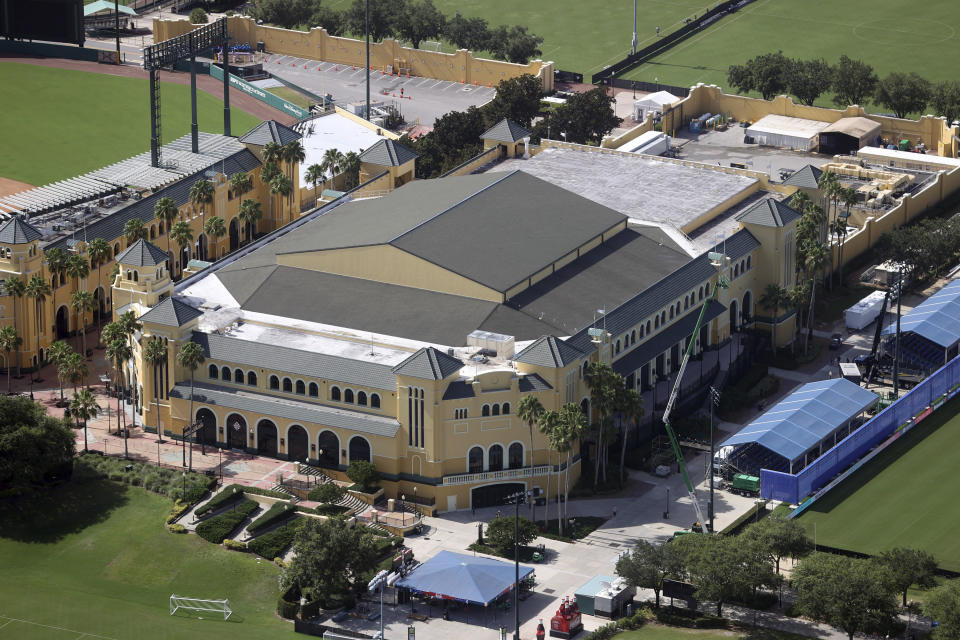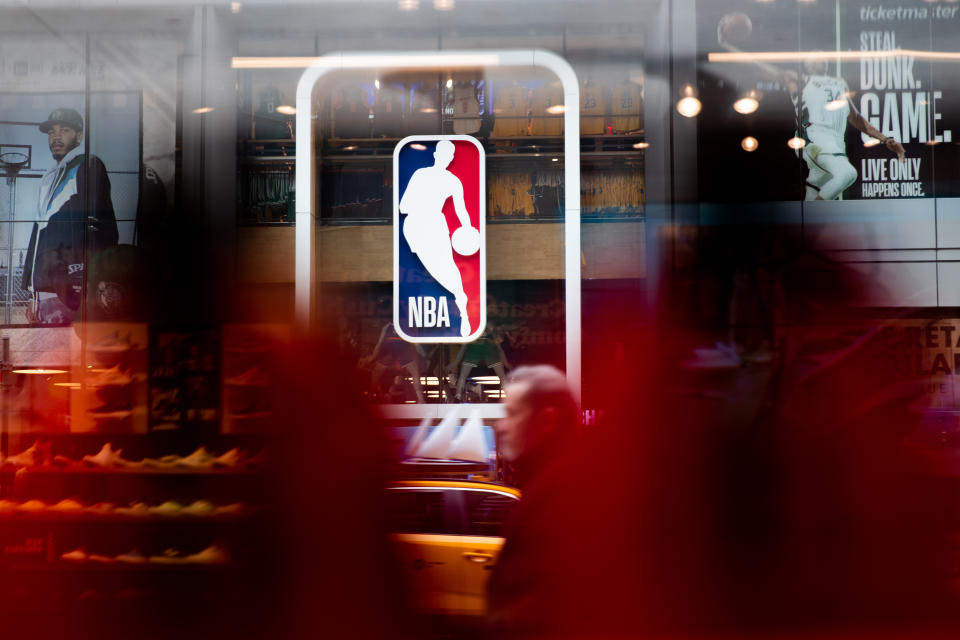Sports amid coronavirus: Are league testing protocols impacting the U.S.’s pandemic fight?
To complete their 2020 seasons, professional sports in the United States will use an estimated one million coronavirus tests. Once the NFL opens training camp later this month, roughly one in every 150 U.S. tests will be used on an asymptomatic athlete or league employee. And that, amid coast-to-coast COVID-19 surges, is problematic to some members of a public dealing with widespread testing delays.
Lines currently wrap around testing facilities at dawn. “Everyone is stressed right now,” says University of Washington pathologist Geoff Baird. The country’s two biggest private labs are returning results to everyday citizens in around a week, rendering the tests borderline useless.
Another major lab, meanwhile, is supplying the NBA and MLS with more than 1,000 tests per day. Results arrive in under 24 hours. And sometimes in less than 12.
“There's always that issue, when sports leagues are using testing in the midst of [problems] with testing capacity,” says Amesh Adalja, an infectious disease expert at Johns Hopkins. “You wonder, are sports teams absorbing that capacity?”
The answer, experts say, at least to some degree, is yes. Answers to adjacent questions — How much capacity are they absorbing? Should they be absorbing it? What’s the net impact on public health? — are complex.

Do sports affect national testing demand?
The NBA and MLS are both paying BioReference, a private lab, for testing. In a Monday interview, BioReference executive chairman Jon Cohen told Yahoo Sports that it’s “absolutely not” fair to say that his company’s commitment to the NBA inhibits its ability to test the general public. “We’ve met every single one of [our] commitments and more for people who need more testing in the state of Florida,” he said. The leagues, essentially, are satisfied with that promise.
Yet just last week, the Florida Department of Health reported that the average turnaround time at one of its main testing sites was six days. The supplier was BioReference. “When BioReference informed the state they were experiencing a nationwide delay in results,” the Florida DOH said, “the state began sending tests from the Orange County Convention Center testing site to Genetworx,” which is another lab.
Across the country, demand is sky-high and increasing. The industry, experts say, can’t keep up. Quest Diagnostics, a Fortune 500 clinical lab, said in a news release Monday that its average turnaround time for “Priority 1 patients,” which “include hospital patients … and symptomatic healthcare workers,” is “slightly more than” 24 hours. For everybody else, it’s “seven or more days.”
Cohen said BioReference’s average turnaround time is 72 hours. He pointed to “competitors” to show that his lab was keeping up with demand better than others.
Experts, however, see the idea that labs are “competitors” as either troubling or misleading. If one isn’t overwhelmed, Baird explains, it could help the many that are. “All those laboratories are taxed, and they're all looking for some place to send extra testing,” he said. “All of the labs talk to all of the labs, constantly. So yes, of course, different laboratories would call up other labs [to ease testing burdens]. Any laboratory would do that … if they could. The problem is that we're all in the same boat right now. All of us are suffering under supply chain problems. There's not a lot of options. If anyone had an idea of who to call — if there was still some place that had extra capacity — people would've called them and filled that capacity.”
So if the NBA and MLS weren’t trying to resume their seasons, testing capacity would open up. Supply chains are convoluted, but “it is very much the case that any one test that's done one place is a test that isn't done somewhere else,” Baird says.
Cohen, later in his interview with Yahoo Sports, seemed to admit this. “So you could say, ‘Oh, you could technically test other people,’” he said. Then he reframed the discussion: “My question for you is, tell me who else I should test. You want me to test teachers? You want me to test the general public? You want me to test another kind of employer? Tell me who I should test.”
Many would argue that BioReference should test anybody who fears they’ve contracted the virus. And that it should get them results in 12 hours, just like it’s doing for asymptomatic athletes.
“Well I'm sure that's true,” Cohen responded. But “nobody in the country is doing that.” The government hasn’t told him who to test. Nobody has the capacity to deliver quick turnarounds at scale. It’s a problem in and of itself, not one created by sports leagues.
Which leads to the real questions here: Do sports leagues meaningfully exacerbate the problem? Is allocating thousands of tests to them instead of the general public actually impactful? Do the benefits — economic, psychosocial, and so on — outweigh the costs?
It’s a microcosm of the dilemma at the heart of the nation’s coronavirus response.
The U.S.’s burdened response
Let’s take a step back. “I want to differentiate,” says University of Colorado professor Daniel Larremore, “between two different kinds of testing.”
A COVID-19 test that isn’t returned for a week, Larremore explains, is a “clinical diagnostic” test. It can help epidemiologists study the pandemic. It can inform a physician’s treatment of long-term health issues. What it can’t do is halt the spread of the disease. It doesn’t allow for contact tracing and isolation of infected individuals. If their period of infectiousness has already elapsed by the time they’re confirmed positive, they can’t act on the result.
High frequency and fast turnaround, therefore, are vital for “surveillance and screening” tests. Larremore recently led a not-yet-peer-reviewed study that highlighted exactly that. And screening tests are what the NBA will do. It will test players daily or every other day, with samples collected “in the evening,” according to its health and safety protocols, “with the goal of retrieving [results] by the following morning.”
“Sports leagues are, in some ways, doing exactly what the rest of the country would want to be doing,” Larremore says.
Thus, many question why sports leagues can if the rest of the country can’t. The answer is money. It is, some feel, a misallocation of resources. It could be the reason Joe Schmo gets tested two days after first experiencing minor symptoms rather than one day. Or the reason he gets his result four days after getting tested rather than three. He might go into work on that fourth day and infect a co-worker, hours before learning he has COVID-19 – and hours after he would have learned, if only a lab had processed his test quicker.
“You also have to think about how these situations can compound one another,” says Zachary Binney, an epidemiologist at Oxford College of Emory University. Joe Schmo’s co-worker could subsequently infect a friend and her spouse, each of whom could infect more people. “The effects get bigger and bigger and bigger and bigger,” Binney explains, “because that's how epidemics work, that exponential growth.”

The unknown is how many times that chain of events will occur. “I don't think that [sports leagues] cutting the line is really going to impact public health more broadly,” Larremore says. Jaline Gerardin, a disease modeling expert at Northwestern University, concurs: “It's probably not a huge amount of transmission.” Even if 5,000 more quick-turnaround tests per day could go to everyday citizens, roughly 90 percent of them will be negative. Some portion of the other 10 percent will be self-isolating while awaiting test results anyway. Only a fraction of the rest will actually infect somebody during the extra lag time that sports leagues indirectly cause.
Plus, if week-long waits persist, the difference between getting a test result in seven days and eight is almost negligible. In other words, the U.S. pandemic response has been so bad that sports-inflicted testing delays might not matter.
Besides, no sports league’s total test haul over the coming months will exceed the United States’ daily haul. The NBA in three-plus months will use less than 25 percent of what the country does in one day. Which leads to what Binney calls a “fair” question: “Taking less than half of a day's testing in the U.S. for an entire [sports] season, isn't that worth it?”
The positives of sports testing
On one hand, the roughly one million tests that sports leagues are estimated to use, and that therefore aren’t available to others, will almost certainly contribute to the spread of the virus among the general public. Some people will get sick. “It's not going to mean thousands of deaths,” Gerardin says. “Probably.” But it might contribute to some.
On the other hand, sports leagues could help labs expand testing capacity. They could help further research. In the long run, that could aid the general public. An NBA spokesperson told Yahoo Sports that the league will “launch a mobile testing site and host a drive-through testing event” in Central Florida this week. It has also partnered with the Yale School of Public Health, the Mayo Clinic and “other leading research institutions” to support studies. MLS is “working with BioReference to provide COVID-19 antibody testing to the Orlando community.”
And, of course, the public will get sports back. “Sports,” says Cohen, the BioReference exec, are “an integral part of American society.” He’s “proud” to be working with leagues. Thousands of people will get joy and other intangible benefits. Hundreds will keep their jobs.
That, essentially, is the argument that Cohen eventually settles on. Binney, like other epidemiologists, just wants to make sure it’s “explicit.” The valid argument is not that the NBA and MLS aren’t using valuable resources — they are. It’s “that we are prioritizing having the NBA and MLS back over some people getting their tests back faster than they otherwise could have,” Binney says. “That is what we are doing. Maybe that's OK with you. It's a moral or value judgment.”
More from Yahoo Sports:

 Yahoo Sports
Yahoo Sports 

